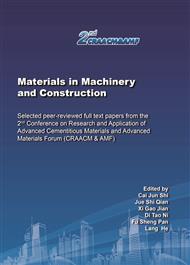p.301
p.309
p.319
p.327
p.337
p.347
p.358
p.371
p.378
Performance Optimization of Cement-Fly Ash Grouting Material Based on Response Surface Methodology
Abstract:
Filling grouting is effective to control the overlying strata movement and surface subsidence in mining and tunnel engineering.Grouting material is used in grouting reinforcement projects. In this experiment,based on the mechanical properties of grouting materials, Expert Design and response surface methodology (RSM) is used to optimize the mix proportion of grout materials. The sand-fly ash ratio ,water reducing agent addition are researched as variables, and the 3D response surface is established between the factors and the performance indicators. Microstructure explains the mechanism of factors affecting performance indicators.The results show the relationship between factors and performance can be well fitted by RSM.The order of significance on compressive strength and solidification ratio is sand-fly ash ratio>water reducing agent addition and the order of significant on viscosity is water reducing agent addition>sand-fly ash ratio.Response surface methodology accurately describes the functional relationship between the target value and the design variables.Microstructure shows hydration reaction and the secondary hydration reaction of fly ash will be carried out after cement-fly ash mixed, and the addition of fly ash is especially important for grout material properties.
Info:
Periodical:
Pages:
337-344
Citation:
Online since:
June 2021
Authors:
Price:
Сopyright:
© 2021 Trans Tech Publications Ltd. All Rights Reserved
Share:
Citation:


